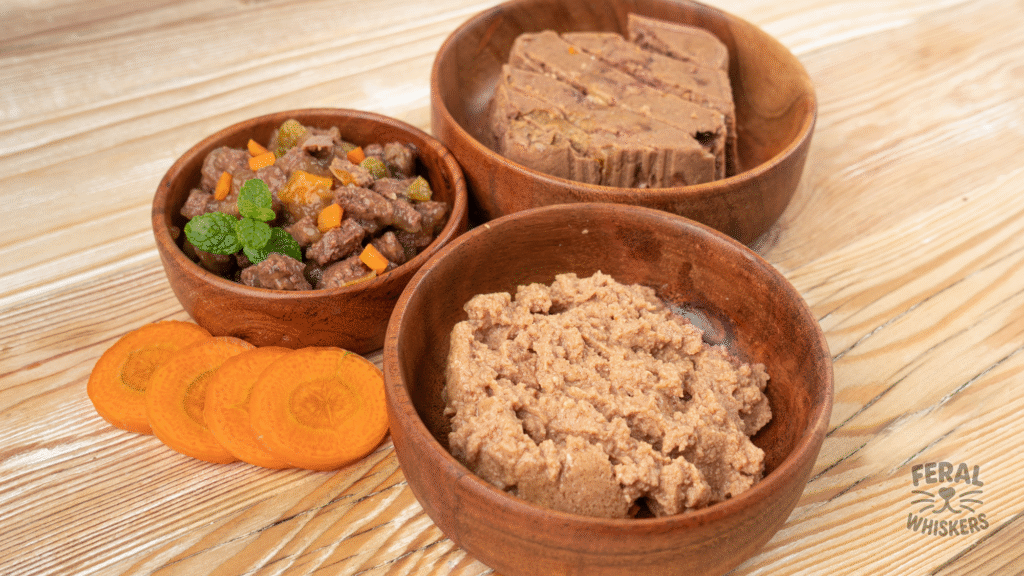📌 Why Canned Food Matters for Cats

Canned food (often called wet food) is one of the most popular choices for modern cat owners. Unlike kibble, wet food is:
- High moisture (~70–80%) – important since cats naturally drink very little water.
- Closer to natural prey consistency compared to dry food.
- More palatable – even picky cats usually prefer wet food.
Because cats are obligate carnivores, canned food nutrition often suits them better than kibble, which usually contains more carbs and fillers.
🐱 Benefits of Feeding Cats Canned Food
- Hydration Support
- Cats evolved from desert animals; they don’t drink much water naturally.
- Wet food boosts hydration, lowering risks of urinary tract disease, kidney problems, and bladder stones.
- Weight Management
- Lower in calories per volume compared to kibble.
- Helps overweight cats reduce calories without feeling hungry.
- Better Digestibility
- Easier for sensitive stomachs to process.
- Often recommended for kittens, seniors, or cats with GI issues.
- Protein‑Rich, Lower Carbs
- Canned diets usually have more meat and fewer carbs than kibble.
- Ideal for carnivores who thrive on protein.
- Palatability & Variety
- Cats are notorious for being picky. Wet food comes in many textures: pate, chunks in gravy, shreds, mousse — increasing acceptance.
🧐 Understanding Labels on Canned Cat Food
Decoding cat food labels is crucial for picking healthy options:
- AAFCO Statement: Look for “Complete and Balanced” — ensures the food meets minimum nutritional standards.
- Life Stage Declaration: Foods may be labeled for kittens, adults, or all life stages. Kittens need higher protein, fat, and calories.
- Ingredient List:
- First ingredients: Should be real meat (e.g., chicken, beef, salmon).
- Avoid long lists of fillers (corn, soy, wheat).
- Guaranteed Analysis:
- Protein, fat, fiber, moisture levels are listed.
- Higher protein and moderate fat are best for cats.
- By‑products: Not always bad — organ meats are highly nutritious, though quality varies by brand.
✅ Types of Canned Cat Food
- Pate: Smooth, mashed texture. Filling, good for adding water or meds.
- Chunks/Slices in Gravy: More hydrating, flavorful, but sometimes higher in carbs.
- Shreds/Flaked: Mimic shredded meat; appealing to picky cats.
- Mousse/Loaf: Very soft, suitable for kittens/seniors with dental issues.
🌿 Holistic Tips for Choosing Wet Food
- Protein Source First: Choose foods listing animal meat first, not starch.
- Single‑ingredient proteins: Useful for cats with food allergies (e.g., rabbit-based or duck-only cans).
- Limited Ingredients: Fewer additives reduces risk of sensitivities.
- Grain‑Free: Cats don’t need grains — focus on animal protein.
- Rotate Brands & Proteins: Prevent picky eating and provide variety.
- Add Holistic Boosts: Mix in probiotics, pumpkin puree, or bone broth for digestive and immune support.
⚠️ Risks or Cons of Canned Cat Food
- Cost: More expensive than kibble.
- Storage: Must be refrigerated after opening and eaten within 24–48 hours.
- Dental health: Doesn’t provide crunch — doesn’t directly clean teeth (though this is less of a benefit than people think).
- Additives in cheap brands: Some use artificial flavors, high sodium, or unnecessary fillers.
💡 Pro Tip: Use portion control — cats often overeat on gravy-based foods if free‑fed.
🍼 When Canned Food is Most Helpful
- Kittens: Softer texture and higher moisture make weaning easier.
- Senior cats: Easier on teeth; helps prevent dehydration.
- Cats with urinary or kidney issues: The moisture content helps flush toxins.
- Picky eaters: Wide variety of textures and flavors encourage appetite.
🧴 Serving and Storage Tips
- Store unopened cans in a cool, dry place.
- Once opened, refrigerate leftovers; warm slightly before serving (cats prefer food close to body temperature).
- Always use clean bowls (stainless steel or ceramic).
- Don’t leave canned food out for more than 2–3 hours.
❓ FAQs
Q1: Is canned food better than dry food for cats?
Yes, because it’s higher in protein, lower in carbs, and adds hydration.
Q2: Can I feed only wet food?
Yes, many cats thrive on canned-only diets if balanced and complete.
Q3: What should I avoid in canned cat food?
Too many fillers (corn, wheat, soy), artificial colors/flavors, carrageenan (linked to GI inflammation).
Q4: How much canned food should I give?
Most adult cats need about 200–250 calories/day. This usually equals 2–3 small cans (3 oz each), depending on activity level.
💡 Final Thoughts
Canned cat food is one of the healthiest, most natural choices for modern feline nutrition — especially compared to dry kibble. It provides hydration, protein, and meat‑based energy cats need, with extra palatability.
✅ Key takeaway: Choose canned food that lists meat first, avoid fillers, and rotate proteins. Combine with holistic toppers like pumpkin or probiotics for optimal feline nutrition.

